Beauty has long been shrouded in mystery. Many have attempted to understand it, to get closer to it – to define it through scientific research (my non-symmetrical face doesn’t come close), capture it through the arts (we’re lookin’ at you, Oscar Wilde), obtain it for ourselves through hours of trial and error in coveted products (I refuse to spend $85 on .5oz of moisturizer, sorry), or sifting through the “Top Shelf” of our beauty idols – yet we hardly delve deep enough to question our own unique relationships with beauty.
Author Autumn Whitefield-Madrano examines the complex and often contradictory relationship women have to beauty in the United States in the age of The Beauty Myth. We had the chance to ask her ten questions regarding her new book Face Value: The Hidden Ways Beauty Shapes Women’s Lives – out today – in which she covers everything from a distinct beauty language that has taken form, our relationships to both females and males, and, of course, the media.
Q: What is your “beauty narrative” and how has it shaped you? Or, how have you shaped your idea of beauty to “loosen the hold” that these standards have had on you in the past?
A. I’ve actually tried to drop any idea that I have a “beauty narrative” in the sense of charting a narrative by how I feel about my looks. Ten years ago I would have said, “Oh, I didn’t like how I looked when I was a teenager but as I grew older I got more comfortable with myself, and look at me now!” That’s true to a degree—most people report being more satisfied with their looks as they age—but that narrative neatly leaves out that I was saying the same things when I was 16 years old! What I do now is try to just acknowledge each moment—I have days when I feel like I’ve really got it going on, and I try to actively appreciate those days and moments, because I also know that there will always be times when I look in the mirror and feel lousy. It’s not really accurate to think that either of those moments accurately represents how the world sees me, so I just acknowledge that those moments exist on a continuum and move on with my day.
I don’t think that my idea of beauty, as far as what beauty might visually look like, has changed dramatically with the writing of Face Value. But my acceptance of my fluctuating self-image has changed, and doesn’t trouble me like it used to. That in itself has helped me loosen the grip of the beauty standard, because I’m not patting myself on the back when I feel like I meet it or beating myself up when I don’t feel like I am. I see it as more fluid now.
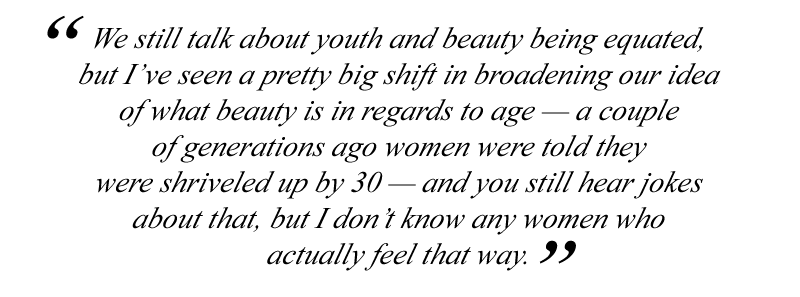
Q: What are the top beauty myths you’d like to dispel right now?
A. The main beauty myth I’d like to dispel is the idea that women just hate how they look. A lot of women are plagued by self-image problems, to be sure, and that’s really painful stuff I don’t want to dismiss. But what I found more often was that women’s beauty esteem simply fluctuated a lot, which can present itself as not liking how you look, because you’re likelier to remember the times you feel crappy as opposed to the times when you feel fine. I worry that when we assume that women’s baseline is self-hatred, that we normalize self-hatred, which is exactly what we shouldn’t be doing.
More superficially, I’d like to see more of an acknowledgment about how our conceptions of age are changing. We still talk about youth and beauty being equated, but I’ve seen a pretty big shift in broadening our idea of what beauty is in regards to age—a couple of generations ago women were told they were shriveled up by 30, and you still hear jokes about that but I don’t know any women who actually feel that way. Maybe this is on my mind a lot because I just turned 40 and genuinely feel like I look better than I did when I was 25, and I know a lot of women who share that sentiment.
Q: You’ve examined beauty and society’s relationship with it extensively throughout your life, on your blog The Beheld, and now in Face Value. Did you find that any other cultures had a healthier relationship with beauty? Did any of these cultures share similar expectations or lines of thought?
A. I focused on American women in the book, and only incidentally looked at other cultures. I did repeatedly find that women in Japan reported being far more dissatisfied with their looks than women in the West, which sort of follows the pattern of people in the West, particularly the United States, being more comfortable with boasting about themselves. I also came across some research indicating that women in Argentina and Brazil might feel less of a taboo about “owning” their beauty, which seems healthier to me, and I think there’s a different level of respect in Latin American culture for the effort of beauty work, and that might translate to a different level of comfort with that ownership. But I don’t really know more than that.
I’m intrigued by countries that have different economic systems than ours. There’s a nasty little stereotype in America about women from Eastern Europe, particularly Russia, that they go over-the-top in self-presentation—helmet hair, “tacky” makeup, that sort of thing. Think of how people regarded Ivana Trump, who’s Czech, for example. But if you were a woman growing up behind the Iron Curtain, with images of democracy and freedom being so closely associated with things like makeup and lotions—not even fancy beauty products necessarily, but something other than whatever color of hair dye the state decided to manufacture that year—wouldn’t you want to indulge in all you could once you were able to?
Q: What did you learn in your research for Face Value that fascinated or surprised you most?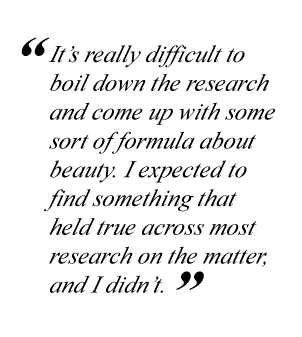
A. I was fascinated by all the contradictions contained within the scholarly and scientific research on what constitutes human beauty. So many of the things that we think are universal traits of beauty—waist-hip ratio, symmetrical features—have a story that’s way more nuanced than “men like women who have little waists.” Which isn’t to say that all those things are total bunk, just that it’s really difficult to boil down the research and come up with some sort of formula about beauty. I expected to find something that held true across most research on the matter, and I didn’t.
On a personal level, I started writing about beauty because I wanted to untangle my own complex relationship to beauty, and I’d assigned that complexity largely to being a feminist who was so intrigued by conventional femininity that I wound up working in mainstream women’s magazines. I learned pretty quickly in talking to women that it wasn’t just me, and it wasn’t just feminists—most women have some level of conflict going on in their relationship to beauty. I went into writing about beauty a little naively on that front, thinking that I had some special-snowflake, terrifically unique perspective. I don’t think I do. What makes my perspective unique is having talked to so many different women about beauty, not my own personal relationship with it.
Q: An overarching theme of Face Value is the contradictory relationship women have with beauty – using makeup as “individualism, play, and expression and as a shameful covering-up of our authentic selves.” How do you see this relationship being rectified presently and in the future?
A. You know, since I wrote the book I’ve been noticing a pretty sharp uptick of that playful aspect of beauty, particularly among millennials. I interviewed millennials for the book but not as millennials, and that’s something I’d like to explore more. That trend of young women dyeing their hair gray, and now the really colorful hair you’re seeing around more and more? That screams of play to me, and I’m glad to see it. Not that taking an overtly artificial, fantastical approach to hair and makeup is the only way to express yourself, but that’s something I only noticed after it was too late for me to really explore it in the book. I find it encouraging.
I also wonder whether there’s a connection between the vastly increased acceptance of the queer community and the ways people are getting more playful with their looks. There’s a long tradition in the LGBTQ world of subverting gender through beauty rites and joyful self-presentation, and that sprang from a need for queer people to commune together and celebrate their position as gender outlaws—if they didn’t create that visible space for themselves, nobody else would. But we’ve seen such a huge shift in the ways American society understands sexuality and sexual orientation, and I wonder if part of that has been an embrace—you could also say co-opting—of these queer modes of operating.
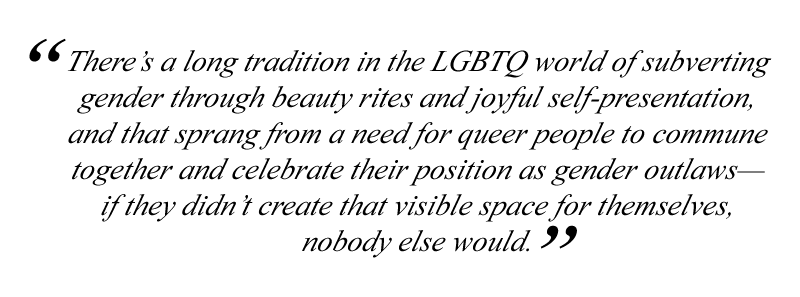
Q: Media and advertising seems to be shifting towards the promotion of being comfortable with oneself. Do you feel that this shift has been superficial or a reflection of reality when compared to actual progress being made? And how does this representation of “Other” forms of beauty help or hinder various minority groups spanning across race, sexuality, use of body modifications, disabilities, etc.?
A. There are two different shifts going on here. Ad campaigns are increasingly co-opting feminist themes—something wonderfully explored in Andi Zeisler’s We Were Feminists Once—and that includes themes of body positivity and self-love. I don’t doubt that many of these come from a place of a genuine desire to boost people’s body image; after all, the minds behind these campaigns are people who have their own shifts in this area. I’m pretty critical of the Dove Campaign for Real Beauty, but the reason I’ve spent so much time ruminating on it is because it’s intriguing, and it’s satisfying to see good-faith attempts on this front. That said, those campaigns are also problematic, even when they’re not superficial.
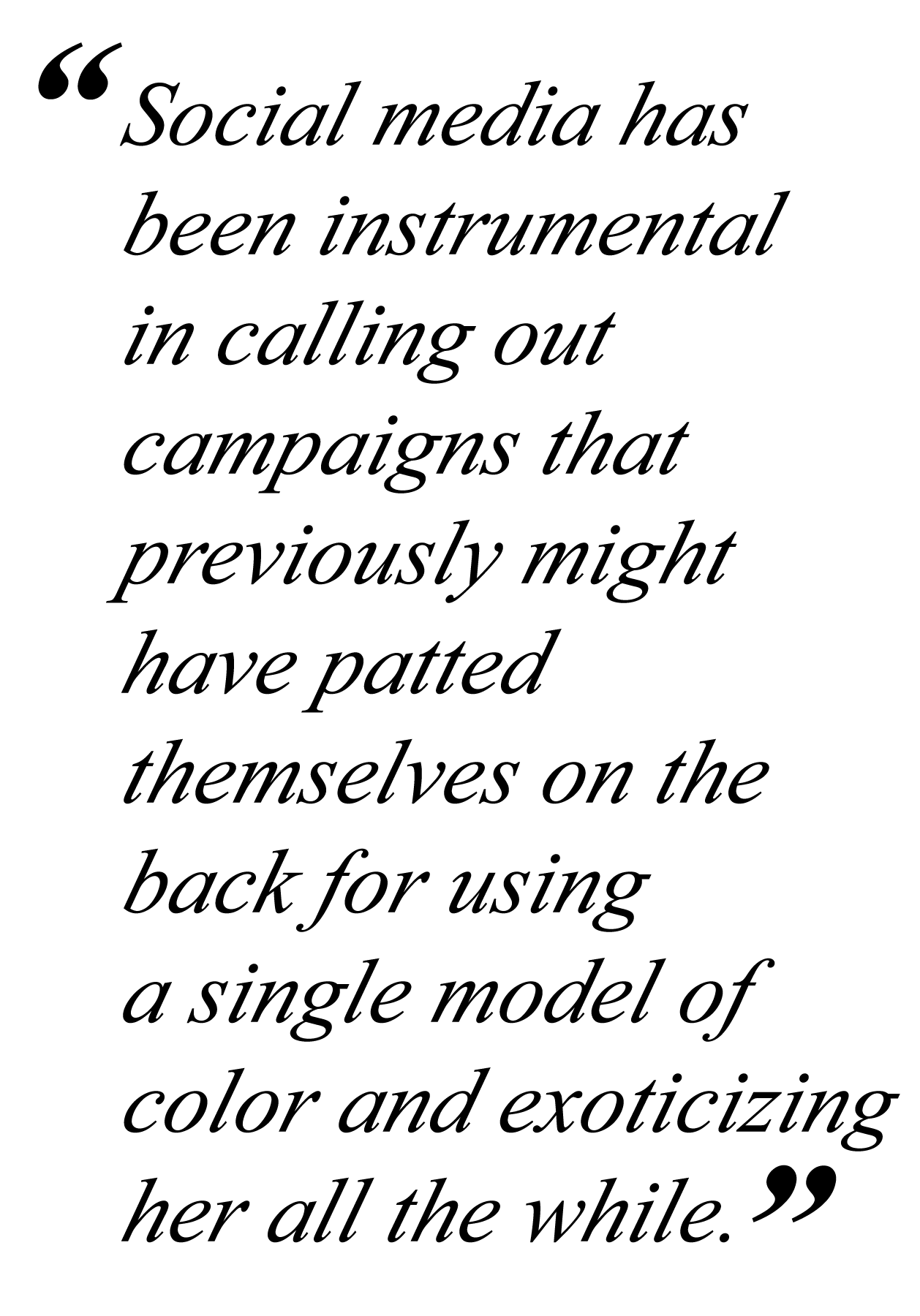 There’s a second shift that’s happened in the past few years, with ad campaigns making some progress in representing groups that have been historically underrepresented. Social media has been instrumental in calling out campaigns that previously might have patted themselves on the back for using a single model of color and exoticizing her all the while. I do see it as an encouraging signal of where America is with understanding that the default American isn’t necessarily a straight white girl who appeals to the male gaze. Media and advertising outlets still figuring out how to be more representative, and there have been missteps there, but I think that it’s going to continue to get better not only in numbers of people represented but also in quality instead of tokenism. At least, I hope so. We’ve got a ways to go, and what people in power need to do is listen to people who have been underrepresented, or misrepresented, and trust their experiences and reactions. If you’re a cis white dude who’s genuinely concerned about these things you might think you’re being progressive by casting a Latina as a white woman’s “spicy” sidekick, but when Latinas roll their eyes, you’ve got to listen to that.
There’s a second shift that’s happened in the past few years, with ad campaigns making some progress in representing groups that have been historically underrepresented. Social media has been instrumental in calling out campaigns that previously might have patted themselves on the back for using a single model of color and exoticizing her all the while. I do see it as an encouraging signal of where America is with understanding that the default American isn’t necessarily a straight white girl who appeals to the male gaze. Media and advertising outlets still figuring out how to be more representative, and there have been missteps there, but I think that it’s going to continue to get better not only in numbers of people represented but also in quality instead of tokenism. At least, I hope so. We’ve got a ways to go, and what people in power need to do is listen to people who have been underrepresented, or misrepresented, and trust their experiences and reactions. If you’re a cis white dude who’s genuinely concerned about these things you might think you’re being progressive by casting a Latina as a white woman’s “spicy” sidekick, but when Latinas roll their eyes, you’ve got to listen to that.
Q: We live in a world of binaries which supports a particular language when defining a female’s beauty and sexuality. You discuss how if you “can’t name it, you can’t shame it” and how the vague language of beauty contributes to the mystification of it as a concept. What are some ways you’d like to see language challenge our concepts of beauty that could help to overcome the contradictory relationship we share with it?
A. Merriam-Webster lexicologist Kory Stamper made a great point when I interviewed her for the book—she pointed out that one of the most recent appearance-centric words to make it into the dictionary was hottie, which is gender-neutral. So there’s some encouraging news on that front, and I’d like to see us go further. Hopefully we will—there’s a growing awareness of gender and gender fluidity that may naturally usher in terms for beauty that aren’t exclusively marked by gender. And I think that awareness may contribute to a demystification of beauty, which in turn could remove some of its disproportionate power. I don’t have enough linguistic imagination to say how I’d like our general stock of words to change—I don’t want to see words like lovely, pretty, striking, and the like disappear by any means. I just don’t want them to have as much weight as they currently do.
I’d like to see us collectively drop words like cankles, “back bacon,” FUPA, etc. But it’s not simply that I want us to stop saying bad things about ourselves—that too, of course—it’s also that I’m troubled by how we come up with these words to apply microscopes to ourselves. Things like a “thigh gap” are ostensibly things we’re supposed to want, but just by the terminology existing we enable a higher level of scrutiny.
Q: You talk about the “worship of images” we have in society and how that has led to the crafting of a person’s online persona – the “play at being” as Simone de Beauvoir defined self-alienation – but you found that the display of a multifaceted self actually reinforced positive feelings of oneself rather than alienation. You tie this in with the fluidity of a person’s identity and how social media can help to keep “one’s self-esteem intact.” Do you feel the line between self-alienation and a multifaceted self is easy to cross?
 A. The line between self-alienation and the fluid self is in itself fluid—from person to person, from moment to moment, from medium to medium. And it’s tricky as an individual because you have to be pretty in tune with yourself to know whether you’re engaging in self-objectification or self-appreciation when you’re creating or sharing images of yourself. I don’t “get” Snapchat as a user at all, but I’m intrigued by it nonetheless—the people I know who are on it seem to have way more fun with it than they do with other social media, and I think part of that is because it’s designed to be ephemeral. From what I can see, it leads to that idea of “play at being” but without the self-alienation that so easily results when we’re talking about a more static representation of oneself.
A. The line between self-alienation and the fluid self is in itself fluid—from person to person, from moment to moment, from medium to medium. And it’s tricky as an individual because you have to be pretty in tune with yourself to know whether you’re engaging in self-objectification or self-appreciation when you’re creating or sharing images of yourself. I don’t “get” Snapchat as a user at all, but I’m intrigued by it nonetheless—the people I know who are on it seem to have way more fun with it than they do with other social media, and I think part of that is because it’s designed to be ephemeral. From what I can see, it leads to that idea of “play at being” but without the self-alienation that so easily results when we’re talking about a more static representation of oneself.
Q: You have a section on male “grooming.” How has male consumption of beauty products affected societal views of the beauty industry? What kinds of effects do you expect to see take place from this shift?
A. I’d love to be optimistic and say that the uptick in the male “grooming” industry is freeing women from a strict beauty standard, thus allowing us all to be more playful with our beauty rituals, but I don’t really see it that way. Instead I’m seeing a sort of doubling-down of the expectation that we all need a lot of products in order to look good. A lot of women I talked with were like, “Good! It’s about time that men had to deal with what women have always dealt with,” but I suspect that if women begin to notice a heightened level of appearance-based anxiety in the men in their lives, that enthusiasm will dwindle. At least women have the luxury of being allowed to be the “emotional” gender and have a sort of permission to talk about our conflicted relationship with appearance. Men by and large don’t yet have that permission.
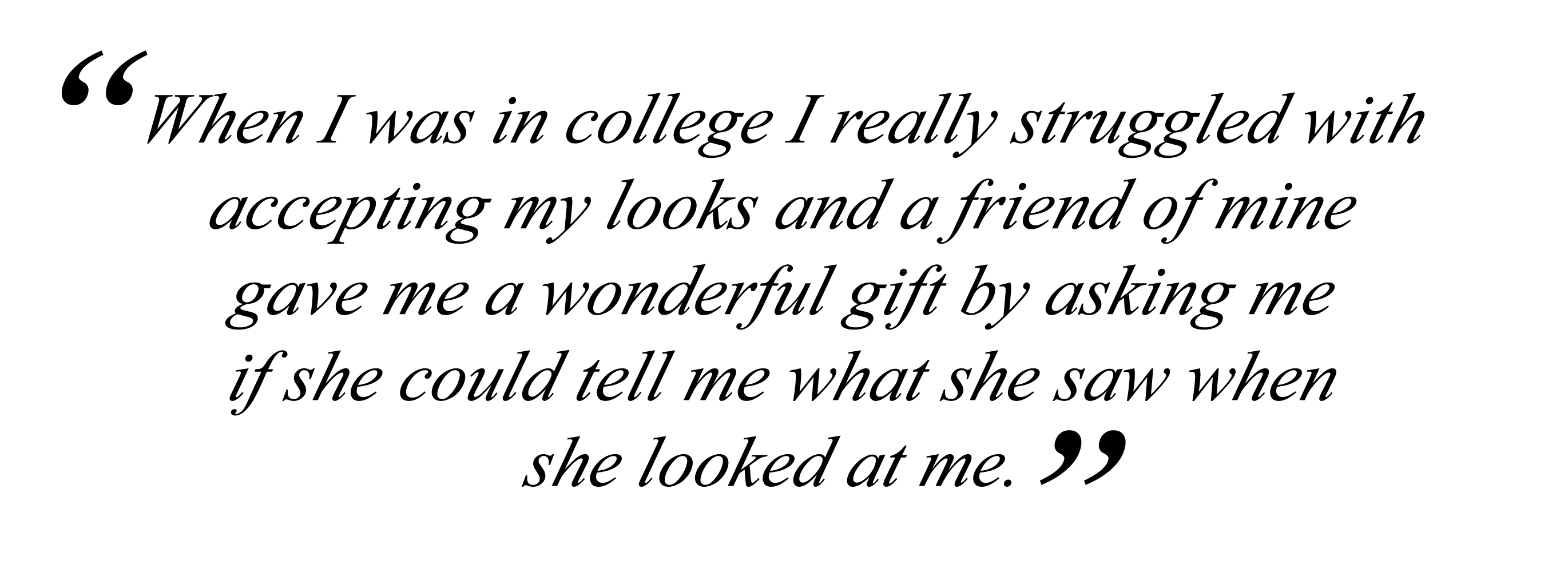
Q: As a child, I remember being told that beauty doesn’t matter – that it didn’t define my worth. Those words of wisdom, while true, didn’t exactly help my younger self cope with the pressures I felt in society to be beautiful. There was no switch I could automatically turn off. What are some strategies you have found that help nurture a healthy self-esteem, in both young women and adults, without dismissing the realities of the world we live in?
A. Something sort of discouraging that I learned about self-esteem is that there isn’t some trick that can help people get there. It’s not 100 percent fixed, but it is a part of your personality, and if your self-esteem isn’t naturally resilient there may just be only so much you can do to heighten it. But you can absolutely nurture it, regardless of where you start out. One theme that came up repeatedly in the scholarly research I sifted through was self-appreciation. Even women who had a strict definition of what beauty was, regardless of whether they felt they met that standard, generally were able to be more at peace with their looks if they appreciated their bodies. You can’t just turn on the self-appreciation switch either, of course, but one way I personally got there was learning more about what my body could do, and sports and athletics are one obvious way to help incorporate that focus. There’s a lot of research out there about how girls who play sports have a more intact sense of self. You don’t need to play sports per se—I’m useless with anything involving a ball—but finding new ways to use your body can help you develop that appreciation of it. I learned that my body is pretty good at lifting heavy things—I mention in the book that I set a goal of deadlifting 200 pounds, and I’m now up to 235! That doesn’t mean I don’t still think about how my body looks, but it has helped my vision of myself become more holistic. Gratitude journals are another way that can help you actively become more appreciative in general—I know they sound all woo-woo but it can be something as simple as ending each day by thinking of one thing you’re grateful for.
I’d also encourage people who are struggling with self-image to talk with someone they trust. When I was in college I really struggled with accepting my looks, and a friend of mine gave me a wonderful gift by asking me if she could tell me what she saw when she looked at me. She didn’t give me platitudes like “you’re beautiful no matter what!”; she simply described myself to me, and while that didn’t magically solve the issue, it was the first time I’d really allowed myself to realize that people weren’t looking at me and deciding whether I was pretty or ugly, but that they saw the entirety of me. If someone is fortunate enough to have a loving, trusted person in their life who you could do that exercise with, that might be helpful.
I’ve also found that simply acknowledging the contradiction between the truth of sayings like “beauty doesn’t matter” and the ways we overvalue beauty in the world can help people who really struggle with guilt about feeling like they shouldn’t care about beauty can be important. Because once you acknowledge that there is a gap, the rituals of beauty can shift from being about meeting some ethereal standard to being about genuinely caring for yourself and allowing yourself to do an appropriate amount of beauty work in a way that lets you feel the most like you. Some women who are approaching their grooming from a position of suffering might do well to let it go for a while—and others who shy away from self-styling might do well to let themselves play with makeup or whatever in a way that lets them find what makes them feel their best.
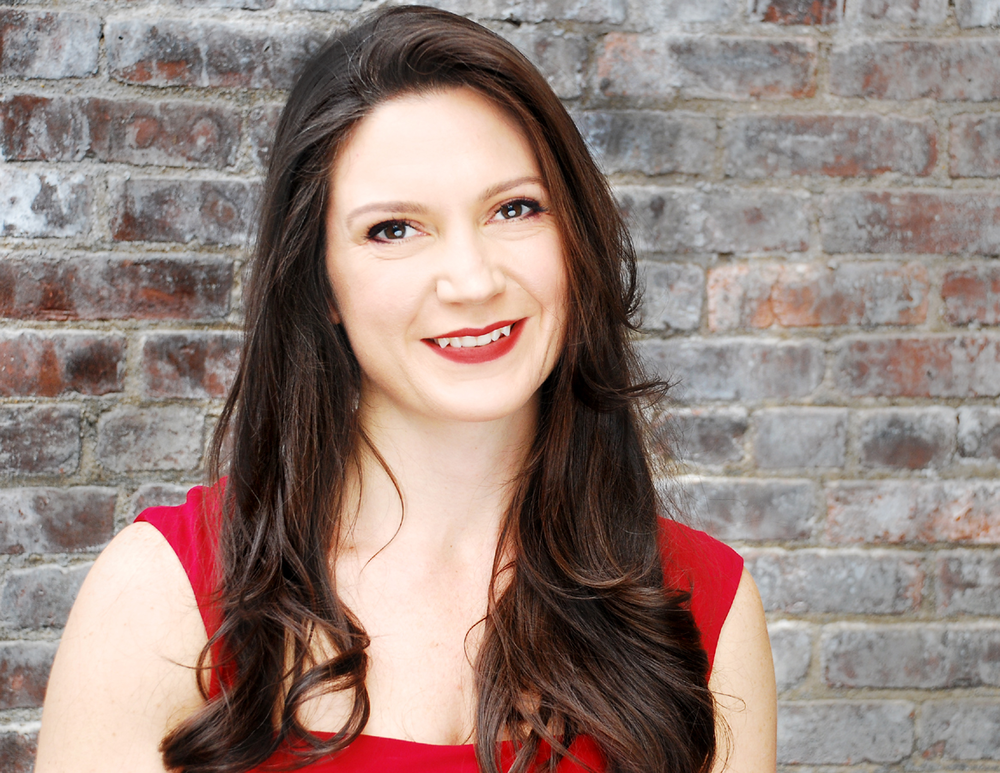 Autumn Whitefield-Madrano is the author of Face Value: The Hidden Ways Beauty Shapes Women’s Lives (Simon & Schuster, 2016). Her writing has appeared in Marie Claire, Glamour, Salon, Jezebel, The Guardian, and more. She created The Beheld, a blog examining questions behind personal appearance. Her work on the ways beauty shapes women’s lives has been covered by The New York Times and the Today show. She lives in Astoria, Queens, and will tell you her beauty secrets if you tell her yours.
Autumn Whitefield-Madrano is the author of Face Value: The Hidden Ways Beauty Shapes Women’s Lives (Simon & Schuster, 2016). Her writing has appeared in Marie Claire, Glamour, Salon, Jezebel, The Guardian, and more. She created The Beheld, a blog examining questions behind personal appearance. Her work on the ways beauty shapes women’s lives has been covered by The New York Times and the Today show. She lives in Astoria, Queens, and will tell you her beauty secrets if you tell her yours.

